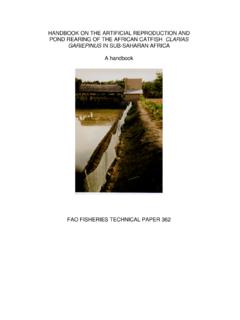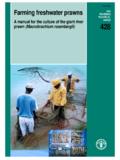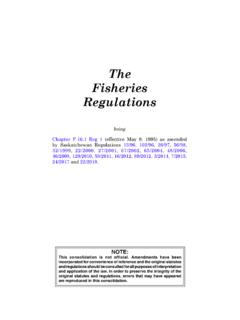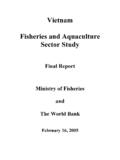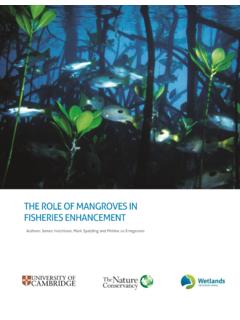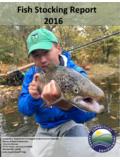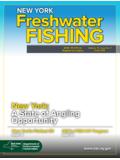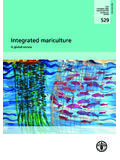Transcription of Development of freshwater fish farming and …
1 April-June 2002 (Vol. VII No. 2)5 Development of freshwater fishfarming and poverty alleviationA case study from BangladeshGertjan de Graaf1 and Abdul Latif21: Nefisco Foundation, Amsterdam, The Netherlands, : Char Development and Settlement Project, Noakhali, BangladeshAquaculture Development in the last decadeBeing a country of rivers and floodplains with a high potentialof aquatic resources, fish plays a very important role in the dailylife of many people in Bangladesh. The Bengali expression Mache Bhate Bengali , or fish and Rice make a Bengali, illustrates this importance. Bangladesh produces 1,400,000tonnes of fish annually mostly through inland capture fisheriesand aquaculture. The Development of the fisheries sector inBangladesh during the last two decades has mainly been donordriven and emphasis has always been laid on the improvementand expansion of the aquaculture sector, which received or willreceive around 60% of the donor funding over the period increase in farmed fish from about 100,000 mt in theearly 1980s to 400,000 mt nowadays is impressive, but still, itonly accounts for 30% of the total production.
2 In the meantime,we see that the major sources of fish - capture fisheries arein trouble. Riverine fisheries are declining, the major carps aredisappearing, and estuarine set bag nets are destroying thejuvenile fish in the Bay of of the 130 million people in Bangladesh are poor and 30million are living in extreme poverty. Poverty reduction andimprovement of the livelihoods of the poorest of the poor hasalways been one of the major goals of Development programmesin Bangladesh and is a major objective in all the aquaculturedevelopment programmes. Whether the benefits of theseprogrammes have been made available to the poor can bequestioned, as their basic strategy: growth of the overall fishproduction through fish farming was in most cases notconsistent with the socio-economic reality of the rural poor inBangladesh.
3 We want to illustrate this point with two case water fish farming developments inthe Compartmentalisation Pilot Project(CPP) and the Char Development andSettlement Project (CDSP).The Compartmentalisation Pilot ProjectThe Compartmentalisation Pilot Project is a water managementproject where a traditional aquaculture Development project wasconducted from 1993-1998. During this period, all 3,000 pondsin the area were engaged in a simple aquaculture extensionprogramme focused on rearing Indian carp (Catla catla, Cirrhinusmrigala, Labeo rohita) and silver carp. The production wasthoroughly monitored and socio-economic data of theparticipants was sub sector Donor funding (US$ million) % Aquaculture 205 59% Fisheries 107 31% Research 34 10% Total 345 100% Table 1: Donor funding in fisheries Development ,Bangladesh, 1986-2005 The programme was successful as the yields increased from800 kg/ha to 2,100 kg/ha and the total production in the projectarea increased by about 300 mt/year.
4 However, from the socio-economic data, we learned that the programme had a very limitedimpact on poverty alleviation. This can be attributed to a largedegree to the fact that only 1% of the landless families and 19%of the marginal farmers have access to a pond (Table 2).Further, the ponds owned by the landless and marginal farmerstend to be small and often do not contain water throughout thewhole year, which results in only 60% being suitable for raisingIndian carp (Figure 2).Therefore, the landless and marginal farmers produce only4% of the farmed fish . Small farmers produce 22%, but the bulk(75%) is produced by the medium and large >3000 Pond sizeNot suitableSuitableFigure 2: Suitability of the ponds for the farming of Indian carps in theCPP project areaFigure 1: The bulk of fish production is by medium and large Asiae Asiae Asiae Asiae Asia6 Table 2.
5 Distribution of ponds and the aquaculture production over the different social strata in the CPP project strata No of rural households in CPP No of ponds in CPP % of households owning a pond Pond size (m2 ) % on pond number % of total pond area % aquaculture production Landless 19,890 237 1% 248 8% 2% 1% Marginal farmer 2,509 475 19% 379 16% 7% 3% Small farmer 4,589 623 14% 899 21% 22% 22% Medium farmer 1,362 1276 94% 1073 43% 53% 57% Large farmer 475 326 69% 1232 11% 16% 18% Total 28,825 2937 Social strata No of rural Households No of ponds % of Households owning a pond Pond size (m2 ) % on number Pond area (ha)
6 % on area Landless & marginal farmers 9164 3912 43% 355 38% 139 28% Small farmers 6266 5862 94% 500 56% 293 58% Medium farmers 562 553 98% 1011 5% 56 11% Large farmers 94 94 100% 1706 1% 16 3% Total 16086 10421 504 Table 3: Distribution of the ponds over the different social strata in the CDSP project highly disproportionate distribution was recognized inthe late 90s, and a Homestead fish Culture programme aimingat the poorest of the poor was developed and successfullyimplemented.
7 This programme was needed; as in the CPP projectarea, the poorest of the poor do not possess suitable ponds. Thisin contrast what is generally believed, that most housesconstructed in rural Bangladesh are built on a raised earthenplinth to avoid flooding, and that therefore all households havea pond. This situation is somewhat different in the coastal areasof Char Development and Settlement ProjectThe main activity of the Char Development and SettlementProject (CDSP), located in the south-eastern part of Bangladesh,is the official settlement of households that installed themselveson the newly accreted coastal lands, the char lands. The projectalso assists productive Development , in particular agriculture,and to some extent of the major problems in the coastal belt and the CDSP project area is the shortage of fresh water during the dry shallow ground water is saline and therefore tube wellscannot be used to provide fresh water during the dry season, asis the case in the rest of Bangladesh.
8 To overcome the dry seasonshortage of fresh water, the digging of ponds for the storage ofrainwater is essential for the population in the coastal of this, relatively more ponds, on average 85 per squarekilometre, are found in the coastal belt if compared with 22 persquare kilometre found in the CPP project area. Further, manymore of the landless and marginal farmers (38%) possess a pond(Table 3), and small farmers own the majority of the the CDSP project area, medium and large farmers ownonly 14% of the ponds. The major reason is that there are notmany rich farmers because most of the population are newsettlers. The improvement of the ponds for aquaculture couldimprove the situation of the rural poor. However, the selectedstrategy of such an aquaculture Development programme is veryimportant in terms of its actual impact on poverty reduction.
9 Another Development strategyIt is often assumed that improvement of ponds for aquaculturewill automatically lead to an improvement of the livelihood ofpoorest of the poor. Unfortunately, it is not that simple, becauseimprovement of fish farming in Bangladesh is not neutral .Owning a pond does not necessarily mean that this pond issuitable for the rearing of fish . On the contrary, the suitabilityfor aquaculture is mainly determined by its size and waterretention ability. In most cases, the latter are interrelated; smallponds do not retain water for a long period, while large pondscan retain water for over nine months. Still, experiences inBangladesh have proved that small ponds can be used forproduction if appropriate fish species and management systemsare general, fish ponds can be classified according toproduction and rearing system as follows: Small ponds (100-200 m2), retaining water for less than 4months.
10 Not suitable for fish (other than African catfish) Small ponds (200-300 m2), retaining water for 4-5 for Thai Puti (Puntius Gonionotus) and Tilapia,production 600 kg/ha/year Small ponds (300-500 m2), retaining water for 5-6 for Thai Puti, Tilapia and common carp, production700 kg/ 2002 (Vol. VII No. 2)7050100150200250300350 Landless &marginal farmerssmall farmermedium farmerlarge farmerPond are a (ha)020040060080010001200140016001800pon d size (sqr m)Pond areasizePOORRICHINDIAN CARPSTHAI PUTI / TILAPIAF igure 3: Pond distribution, pond size, poverty alleviation and aquaculturetechniques in the CDSP-II project 4: production perspectives of freshwater fish farming in the CDSP project areaSocial strata Annual production (t/year) % of total production Kg/family/year Landless 132 24% 34 Small farmer 309 55% 53 Medium farmer 84 15% 152 Large farmer 32 6% 303 557 Medium-sized ponds (500-800 m2), retaining water for 7-10months.
